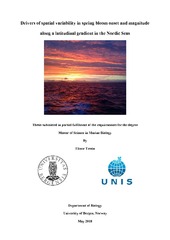Drivers of spatial variability in spring bloom onset and magnitude along a latitudinal gradient in the Nordic Seas
Master thesis
Permanent lenke
https://hdl.handle.net/1956/18088Utgivelsesdato
2018-06-21Metadata
Vis full innførselSamlinger
Sammendrag
Spring phytoplankton blooms in the Nordic Seas contribute a large proportion of global primary production, and their timing and magnitude heavily impacts higher trophic levels. Two key drivers of bloom development, stratification and irradiance, vary seasonally and with latitude. In this study, spring blooms along a latitudinal gradient in the Nordic Seas were observed in ocean color measurements and simulated in an idealized water column model with irradiance and vertical mixing (largely controlled by density stratification) as its main drivers. In both ocean color observations and simulations, a delay in spring bloom onset was observed south of 75°N. Phytoplankton dynamics in the idealized water column model were shown to be highly sensitive to turbulent diffusivity, a measure of vertical mixing highly dependent on stratification. Within a range of turbulent diffusivity, increased turbulent diffusivity led to delayed blooms with higher growth rates and magnitudes. At higher rates of mixing, population growth could not be sustained at the level required for a bloom, resulting instead in steady lowlevel phytoplankton concentrations. These results suggest that latitudinal variation in bloom timing can to a large degree be explained by latitudinal gradients of density stratification and irradiance.
